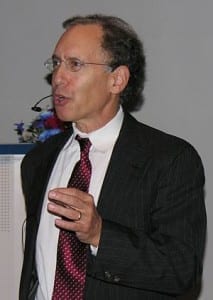
HOW do you take particles in a test tube, or components in a tiny chip, and turn them into a $100 million company?
Dr. Robert Langer, 64, knows how. Since the 1980s, his Langer Lab at the Massachusetts Institute of Technology has spun out companies whose products treat cancer, diabetes, heart disease and schizophrenia, among other diseases, and even thicken hair.
The Langer Lab is on the front lines of turning discoveries made in the lab into a range of drugs and drug delivery systems. Without this kind of technology transfer, the thinking goes, scientific discoveries might well sit on the shelf, stifling innovation.
A chemical engineer by training, Dr. Langer has helped start 25 companies and has 811 patents, issued or pending, to his name. That’s not too far behind Thomas Edison, who had 1,093. More than 250 companies have licensed or sublicensed Langer Lab patents.
Polaris Venture Partners, a Boston venture capital firm, has invested $220 million in 18 Langer Lab-inspired businesses. Combined, these businesses have improved the health of many millions of people, says Terry McGuire, co-founder of Polaris.
Along the way, Dr. Langer and his lab, including about 60 postdoctoral and graduate students at a time, have found a way to navigate some slippery territory: the intersection of academic research and the commercial market.
Over the last 30 years, many universities — including M.I.T. — have set up licensing offices that oversee the transfer of scientific discoveries to companies. These offices have become a major pathway for universities seeking to put their research to practical use, not to mention add to their revenue streams.
In the sciences in particular, technology transfer has become a key way to bring drugs and other treatments to market. “The model of biomedical innovation relies on research coming out of universities, often funded by public money,” says Josephine Johnston, director of research at the Hastings Center, a bioethics research organization based in Garrison, N.Y.
Just a few of the products that have emerged from the Langer Lab are a small wafer that delivers a dose of chemotherapy used to treat brain cancer; sugar-sequencing tools that can be used to create new drugs like safer and more effective blood thinners; and a miniaturized chip (a form of nanotechnology) that can test for diseases.
The chemotherapy wafer, called the Gliadel, is licensed by Eisai Inc.The company behind the sugar-sequencing tools, Momenta Pharmaceuticals, raised $28.4 million in an initial public offering in 2004. The miniaturized chip is made by T2Biosystems, which completed a $23 million round of financing in the summer of 2011.
“It’s inconvenient to have to send things to a lab,” so the company is trying to develop more sophisticated methods, says Dr. Ralph Weissleder, a co-founder, with Dr. Langer and others, of T2Biosystems and a professor at Harvard Medical School.
FOR Dr. Langer, starting a company is not the same as it was, say, for Mark Zuckerberg with Facebook. “Bob is not consumed with any one company,” says H. Kent Bowen, an emeritus professor of business administration at Harvard Business School who wrote a case study on the Langer Lab. “His mission is to create the idea.”
Dr. Bowen observes that there are many other academic laboratories, including highly productive ones, but that the Langer Lab’s combination of people, spun-out companies and publications sets it apart. He says Dr. Langer “walks into the great unknown and then makes these discoveries.”
via The New York Times – HANNAH SELIGSON
The Latest Streaming News: Starting a company updated minute-by-minute
Bookmark this page and come back often
Latest NEWS
Latest VIDEO







